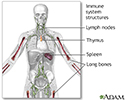Aging changes in immunity
Your immune system helps protect your body from foreign or harmful substances. Examples are bacteria, viruses, toxins, cancer cells, and blood or tissues from another person. The immune system makes cells and antibodies that destroy these harmful substances.
Antibodies
An antibody is a protein produced by the body's immune system when it detects harmful substances, called antigens. Examples of antigens include micr...

AGING CHANGES AND THEIR EFFECTS ON THE IMMUNE SYSTEM
As you grow older, your immune system does not work as well. The following immune system changes may occur:
- The immune system becomes slower to respond. This increases your risk of getting sick. Flu shots or other vaccines may not work as well or protect you for as long as expected.
-
An
autoimmune disorder
may develop. This is a disease in which the immune system mistakenly attacks and destroys healthy body tissues.
Autoimmune disorder
An autoimmune disorder occurs when the body's immune system attacks and destroys healthy body tissue by mistake. There are more than 80 types of aut...
 ImageRead Article Now Book Mark Article
ImageRead Article Now Book Mark Article - Your body may heal more slowly. There are fewer immune cells in the body to bring about healing.
-
The immune system's ability to detect and correct cell defects also declines. This can result in an increased risk of
cancer
.
Cancer
Cancer is the uncontrolled growth of abnormal cells in the body. Cancerous cells are also called malignant cells.
Read Article Now Book Mark Article
PREVENTION
To decrease the risks from immune system aging:
- Get the flu and pneumonia vaccines, and any other vaccines your health care provider recommends.
- Get plenty of exercise. Exercise helps boost your immune system.
- Eat healthy foods. Good nutrition keeps your immune system strong.
- DO NOT smoke. Smoking weakens your immune system.
-
Limit your intake of alcohol
. Ask your provider how much alcohol is safe for you.
Limit your intake of alcohol
Alcohol use involves drinking beer, wine, or hard liquor.
Read Article Now Book Mark Article - Look into safety measures to prevent falls and injuries. A weak immune system can slow healing.
OTHER CHANGES
As you grow older, you will have other changes, including in your:
-
Hormone production
Hormone production
The endocrine system is made up of organs and tissues that produce hormones. Hormones are natural chemicals produced in one location, released into ...
 ImageRead Article Now Book Mark Article
ImageRead Article Now Book Mark Article -
Organs, tissues, and cells
Organs, tissues, and cells
All vital organs begin to lose some function as you age during adulthood. Aging changes occur in all of the body's cells, tissues, and organs, and t...
 ImageRead Article Now Book Mark Article
ImageRead Article Now Book Mark Article
References
McDevitt MA. Aging and the blood. In: Fillit HM, Rockwood K, Young J, eds. Brocklehurst's Textbook of Geriatric Medicine and Gerontology . 8th ed. Philadelphia, PA: Elsevier; 2017:chap 24.
Tummala MK, Taub DD, Ershler WB. Clinical immunology: immune senescence and the acquired immune deficiency of aging In: Fillit HM, Rockwood K, Young J, eds. Brocklehurst's Textbook of Geriatric Medicine and Gerontology . 8th ed. Philadelphia, PA: Elsevier; 2017:chap 93.
Walston JD. Common clinical sequelae of aging. In: Goldman L, Schafer AI, eds. Goldman-Cecil Medicine . 25th ed. Philadelphia, PA: Elsevier Saunders; 2016:chap 25.
-
Immune system structures - illustration
The immune system protects the body from potentially harmful substances. The inflammatory response (inflammation) is part of innate immunity. It occurs when tissues are injured by bacteria, trauma, toxins, heat, or any other cause.
Immune system structures
illustration
-
Immune system structures - illustration
The immune system protects the body from potentially harmful substances. The inflammatory response (inflammation) is part of innate immunity. It occurs when tissues are injured by bacteria, trauma, toxins, heat, or any other cause.
Immune system structures
illustration
Review Date: 8/22/2016
Reviewed By: Laura J. Martin, MD, MPH, ABIM Board Certified in Internal Medicine and Hospice and Palliative Medicine, Atlanta, GA. Also reviewed by David Zieve, MD, MHA, Isla Ogilvie, PhD, and the A.D.A.M. Editorial team.

